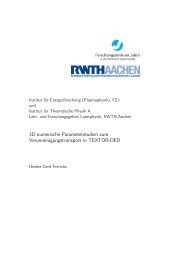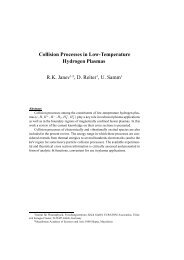The data file AMJUEL: Additional Atomic and Molecular ... - eirene
The data file AMJUEL: Additional Atomic and Molecular ... - eirene
The data file AMJUEL: Additional Atomic and Molecular ... - eirene
Create successful ePaper yourself
Turn your PDF publications into a flip-book with our unique Google optimized e-Paper software.
we have subtracted the (negative) potential energy contribution from these coefficients before<br />
fitting.<br />
More generally, the fitted coefficients, therefore, read:<br />
⟨σ · v · E⟩fit = ⟨σ · v · E⟩ − ∆Esubtr.⟨σ · v⟩<br />
with ∆Esubtr. specified for each particular rate coefficient below, together with the fitting coefficients.<br />
By default we have chosen ∆Esubtr. = 0. in this expression for all processes in which the<br />
potential energy is enhanced (“sub-elastic” processes, such as ionization, excitation).<br />
For the opposite case (recombination, collisional de-excitation, i.e., “super-elastic” processes,<br />
we have chosen ∆Esubtr. = ∆Epot<br />
One can show with some boring algebra on the matrices which arise in collisional radiative<br />
models that with this particular choice of the subtracted energy loss rate for collisional radiative<br />
electron cooling rates the remaining fitted expression ⟨σ · v · E⟩fit turns out to be exactly the<br />
radiation energy loss rate associated with a particular process.<br />
In other words: the total effective electron cooling rate is the sum of the effective radiation<br />
energy loss rate plus the effective potential energy loss rate, however, with the latter rate being<br />
simply given as<br />
⟨σ · v · ∆Epot⟩effective = ∆Epot · ⟨σ · v⟩effective<br />
In this expression ⟨σ · v⟩effective is just the effective rate coefficient for the process under consideration,<br />
i.e. the coefficient for the same process as given in section H.4.<br />
29




